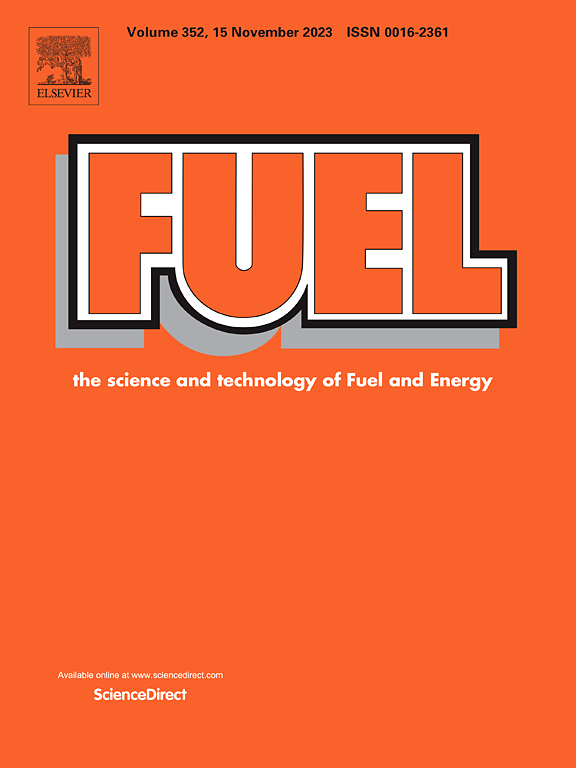重载高氨比工况下氨柴油双燃料发动机特性分析及可行性改进策略评价
IF 7.5
1区 工程技术
Q2 ENERGY & FUELS
引用次数: 0
摘要
交通运输业的脱碳和减少对化石燃料的依赖依赖于无碳燃料的快速和大规模采用。本文基于OpenFOAM和Lib-ICE代码,采用经过验证的数值框架,对氨口喷射和柴油直喷的氨柴油双燃料发动机进行了系统模拟,重点研究了具有显著减碳潜力的重负荷、高氨比工况。面对大负荷、高氨比工况下未燃NH3排放量增大、热效率低的挑战,本研究旨在探索这一特殊且关键工况下的特点及可行的改进策略。其中,本研究的发动机负荷和排量为16 bar,表示平均有效压力(IMEP)分别约为最大负荷的90%和1.327 L。首先,研究了70%、80%和90%氨能比(AER)的参考案例。能量平衡和排放分析表明,有相当一部分氨能未被利用,导致温室气体减排效果不理想,热效率低。在柴油质量有限的情况下,优化柴油的点火分布和后续的氨能活化变得至关重要。对未燃氨区进行了详细分析,指出了在AER70和AER80工况下采用柴油喷射策略改善的潜力,在AER90工况下提出了引入氢的策略。通过对AER70条件下先进SOI和柴油分喷策略的比较,可以看出分喷的优越性,在SOI1 =−60°CA ATDC、SOI2 =−10°CA ATDC、SOI2 =−10°CA ATDC条件下,与原始情况相比,分喷的未燃NH3分别减少了85.38%、99.88%、41.48%、81.70%,ITE分别提高了15.61%、13.45%。在AER80条件下,由于合理的柴油分布和反应性分层,SOI = - 30°CA ATDC的改善效果最好,ITE提高16.41%,NH3降低95.81%,N2O降低69.55%。在AER90条件下,通过端口喷射引入氢气与氨气进行均匀预混。氢对后期氨燃烧的影响主要体现在随着HER的升高,OH自由基峰和放热第二峰的增加。然而,持续的氢气引入并没有取得显著的改善效果。综上所述,通过适当的燃烧控制策略,高氨比(70%、80%)具有温室气体减排优势和高负荷工况下适当的热效率,具有实际应用前景。本文章由计算机程序翻译,如有差异,请以英文原文为准。
The characteristics analysis and feasible improvement strategy evaluation for ammonia-diesel dual-fuel engine under heavy load and high ammonia ratio conditions
The decarbonization and reduction of dependence on fossil fuel for transportation industry relies on the rapid and large-scale adoption of carbon free fuels. This paper conducts systematical simulations for the ammonia-diesel dual-fuel engine with ammonia port injection and diesel direct injection with a validated numerical framework based on OpenFOAM and the Lib-ICE codes, focusing on the heavy load and high ammonia ratio conditions with significant carbon reduction potential. Facing the challenges of enlarged unburned NH3 emissions and low thermal efficiency under heavy load and high ammonia ratio conditions, the aim of this study is to explore the characteristics and feasible improvement strategies under this special and crucial operation condition. Wherein, the engine load and displacement of this study is 16 bar Indicated Mean Effective Pressure (IMEP) approximate 90 % of the maximum load and 1.327 L, respectively. Firstly, the reference cases with 70 %, 80 % and 90 % ammonia energy ratios (AER) are investigated. The energy balance and emissions analysis indicate that a significant portion of ammonia energy remains unutilized, leading to suboptimal greenhouse gas reduction effectiveness and low thermal efficiency. Given the limited diesel mass, optimizing diesel distribution for ignition and subsequent ammonia energy activation becomes crucial. Detailed analysis of unburned ammonia region indicates the potential of improvement through diesel injection strategy for AER70 and AER80 conditions, while the hydrogen introduction strategy is then proposed for AER90 condition. The comparison of advanced SOI and diesel split injection strategy under AER70 condition shows the superiority of split injection since comparing with the original case, it achieves 85.38 %, 99.88 % unburned NH3 reduction, 41.48 %, 81.70 % greenhouse gas reduction, 15.61 %, 13.45 % ITE increase with SOI1 = −60°CA ATDC, SOI2 = −10, −15°CA ATDC conditions, respectively. Under AER80 condition, due to proper diesel distribution and reactivity stratification, the case with SOI = −30°CA ATDC obtains best improvement effectiveness, resulting in notable 16.41 % ITE increase, 95.81 % NH3 and 69.55 % N2O reduction. Under AER90 condition, hydrogen is introduced and homogenously premixed with ammonia through port injection. Hydrogen mainly makes a difference to later ammonia combustion, as evidenced by the increases in OH radical peak and second peak of heat release with the rise of HER. However, continuous hydrogen introduction fails to achieve significant improvement effectiveness. In conclusion, through proper combustion control strategies, the high ammonia ratio (70 %, 80 %) is promising for practical application with greenhouse gas reduction advantage and proper thermal efficiency under heavy load condition.
求助全文
通过发布文献求助,成功后即可免费获取论文全文。
去求助
来源期刊

Fuel
工程技术-工程:化工
CiteScore
12.80
自引率
20.30%
发文量
3506
审稿时长
64 days
期刊介绍:
The exploration of energy sources remains a critical matter of study. For the past nine decades, fuel has consistently held the forefront in primary research efforts within the field of energy science. This area of investigation encompasses a wide range of subjects, with a particular emphasis on emerging concerns like environmental factors and pollution.
 求助内容:
求助内容: 应助结果提醒方式:
应助结果提醒方式:


